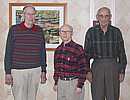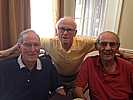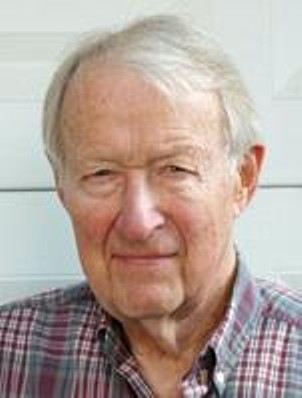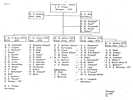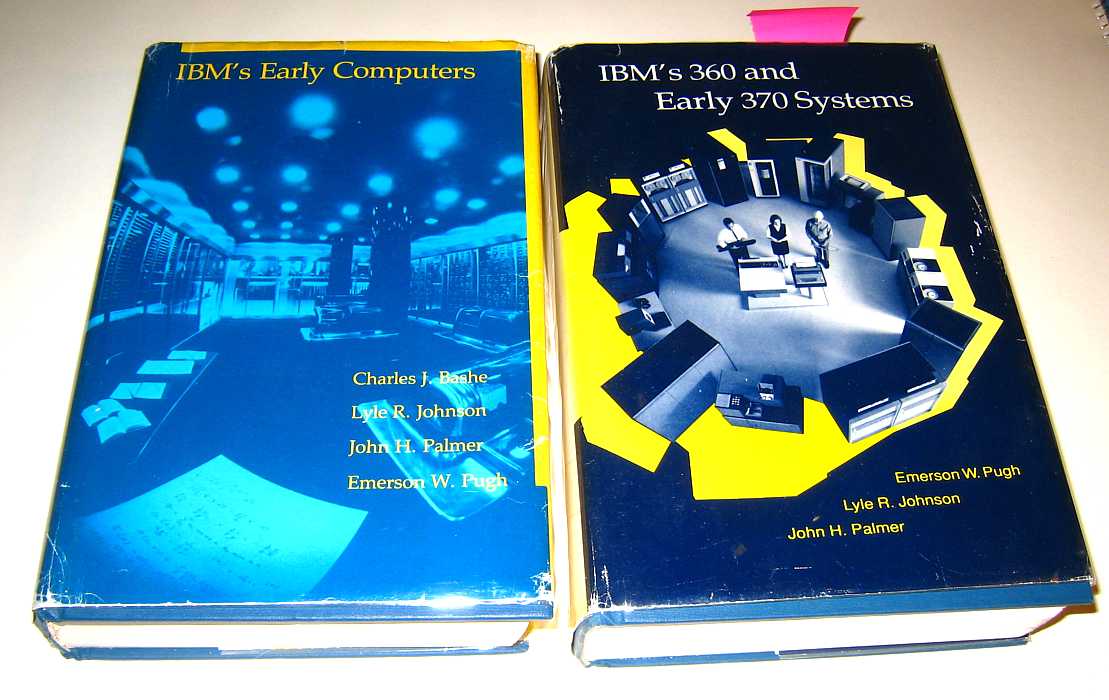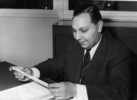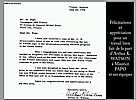return to main 1401 Restoration Page
The bios of the 2000s IBM 1401 2000s Restoration Team are here
IBM 1401 1950s Team Bios
including goals, architecture, design, software, production, marketing teams
Endicott Reunion 2009 - from John Pokoski

(L-R)
Byron Rucker mag tapes; Jud McCarthy cpu; Joe Papa I/O, John Pokoski cpu: Tom Schappe I/O; Andy Kisacky cpu; Paul Farbanish cpu
The following is a list of team members, with links to their listings
WWAM, World Wide
Accounting Machine
Karl Ganzhorn
Papo, Maurice
| IBM 1401 teams
Hardware
Ahearn, George R
Bloom, Earl
Branscomb, Charles E.
Ingram, Jim
McCarthy, Justin
Pokoski, John
Underwood, Fran
| Software
Macklin, David
Mokotoff, Gary
Palmer, Jack
Smillie, Stan
Wertheim, John
| Marketing
Jacobs, Shel
Swanson, Jan
| Higher
Management
John Haanstra
after 1961
| 1403
Berwin Darrow
Gene Darrow
- provided this list
John Drejza
Don Manning
Robert Gibson
Robert Greaves
Jim Walsh
Tim Hayes
- Hammer Unit
- Hydraulic Carriage
|
|
Jud McCarthy generated a more complete staffing document.
Courtesy of Susan Sherwood, Center for Technology & Innovation
Related web pages -
A constraint on the 1401 system design - "solid state in '58" dictate prevented the 1401 system from using tubes.
There is one, in a test/alignment circuit - really hidden !! You have to take the 1402 apart to find it. ;-))
Delco developed the high-voltage germanium power transistors for the 1403 hammer drivers.
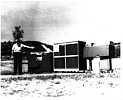
"Dawn of a New Era"
|
Shel Jacobs with 1401 chassis mockups (note the odd 1401 lights panel) used for the initial announcement pics -- (ironically taken at sunset, on the hill above Endicott plant.)
Shel says: "This was one of several location alternatives considered for the announcement video. We were moving the boxes between buildings. It was considered as part of the theme, "Dawn of a New Era". I still remember a comment made by one of the movers - "I'm glad there isn't a lake nearby, we'd be trying to put these things into rowboats.". The video was shot over a 3 day sleepless weekend.
"I'd suggest using "The start of another day".
|
From Jud McCarthy
Ahearn, George R - deceased


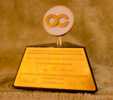

dig the signatures !
|
GEORGE R. AHEARN - PROFESSIONAL EXPERIENCE
- 1956 Bachelor of Electrical Engineering, Villanova University, Villanova Pa.
- 1959 Master Electrical Engineering Catholic University of America, Washington DC
sponsored by National Security Agency
- Military:
Assigned as a U.S. Navy officer to the National Security Agency developing engineering equipment.
-
1958: Joined IBM at the Glendale Laboratory in Endicott N.Y. Assigned to a Special System being developed for the U.S. Government. Manager Wayne Brooke who reported to Peter Fagg, who reported to Bob O. Evans.
- 1958 Special System cancelled then transferred to the 1401 Central Processor development, reporting to Russ Rowley. Remained in that department throughout the design, debug, and Product Test of the ?A? model which qualified the product for announcement.
- 1960 Assigned to a department managed by Fran Underwood who had responsibility, among other efforts, for the attachment of a RAMAC disk file to the 1401. This effort was joined by several engineers on loan from IBM San Jose and together we designed the integration of the IBM 1405 to the IBM 1401 System.
- 1963 Assigned as the 1401 System representative on the team which developed the 1401 Emulator For System / 360. This was a firmware (microcode) effort written to run on the microprocessor within the System / 360 Model 30.
- 1964 Engineering assignments with follow on systems within the 1401 family.
- 1965 Assigned to the staff of the Engineering Manager of Small Commercial Systems, Gilbert Baskin.
- 1966 Assigned manager of the IBM 1285 Optical Character Recognition product development. This s a journal roll reader with application in the retail industry.
- 1967 Transferred to IBM San Jose development laboratory. Managed development of the IBM 2835 fixed head file control unit.
- 1977 Managed the Advanced Systems Technology department which researched the design, performance simulations, and cache management algorithms for high performance subsystems including RAM disk and magnetic disk storage.
- 1980 Program manager for direct access storage subsystems. Responsible for disk storage controllers then in current production as well as development of future products in that class
|
Bloom, Earl
| Preliminary - swak at prodigy dot net
I had nothing to do directly with the 1403 printer mechanisms but with the printer electronic controls including the Universal Character Set electronics for which I got an Outstanding Contribution Award. I also designed the controls for the 1404 Bill Feed and have patents on that and the UCS. I was responsible for other printer control concepts and designs including the tapeless carriage control concepts, numeric print feature controls, Selective Tape Lister controls, etc.
In addition, I helped design the Multiply/Divide and Process Overlap for the 1401 as well as some of the power sequencing controls. I had the pleasure of demonstrating the 1401 system at the Banco de Roma in Rome and Milan in June of 1960 with Mason Cunningham and Bill Jones.
Subsequently, John Haanstra our Division President, myself, Cliff Martin and another individual whose name I can't remember, together architected the 1401 Model G with a concept of Cycle Interleaving. I was given responsibility as only a Senior Associate Engineer to technically manage the overall development and scheduling for the 1401 G and we shipped it ahead of schedule because Haanstra gave me the exact individuals to do the job that I had asked for by name.
Those were the days when you could develop products expeditiously because upper management was actively involved in a supportive manner to ensure you got what you needed to do so.
|
Branscomb, Charles E. -
Obituary
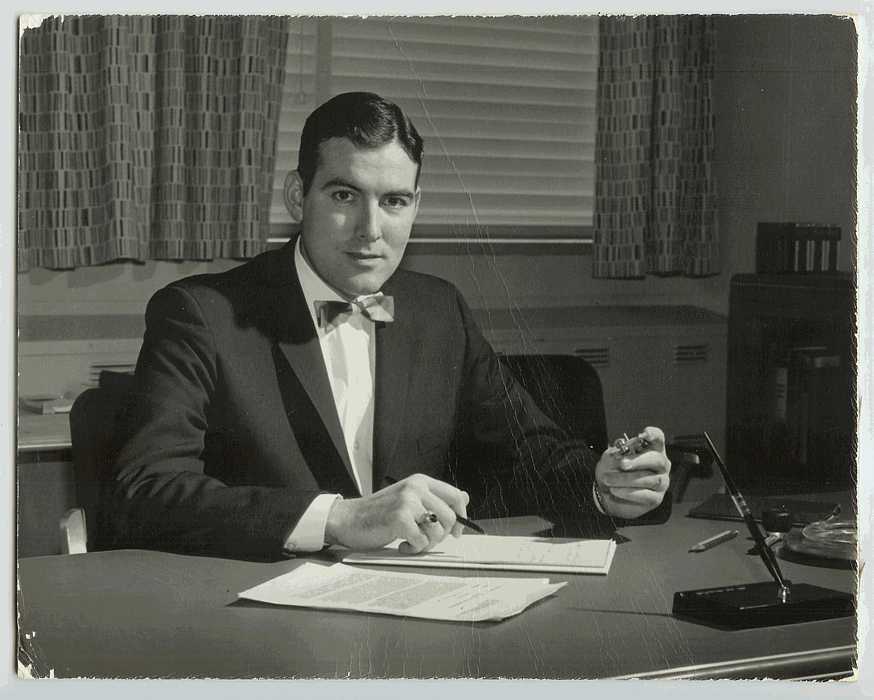
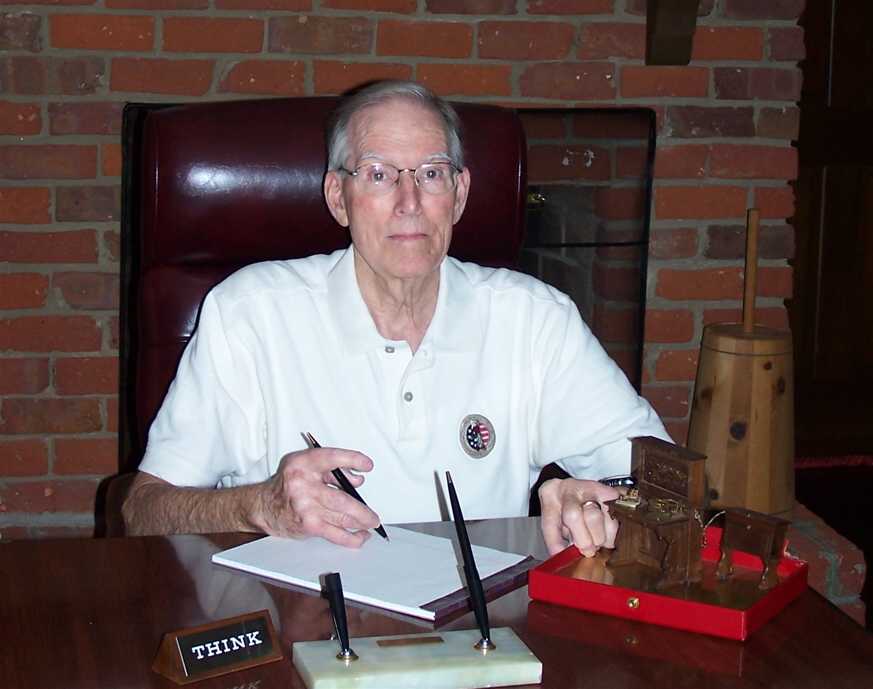
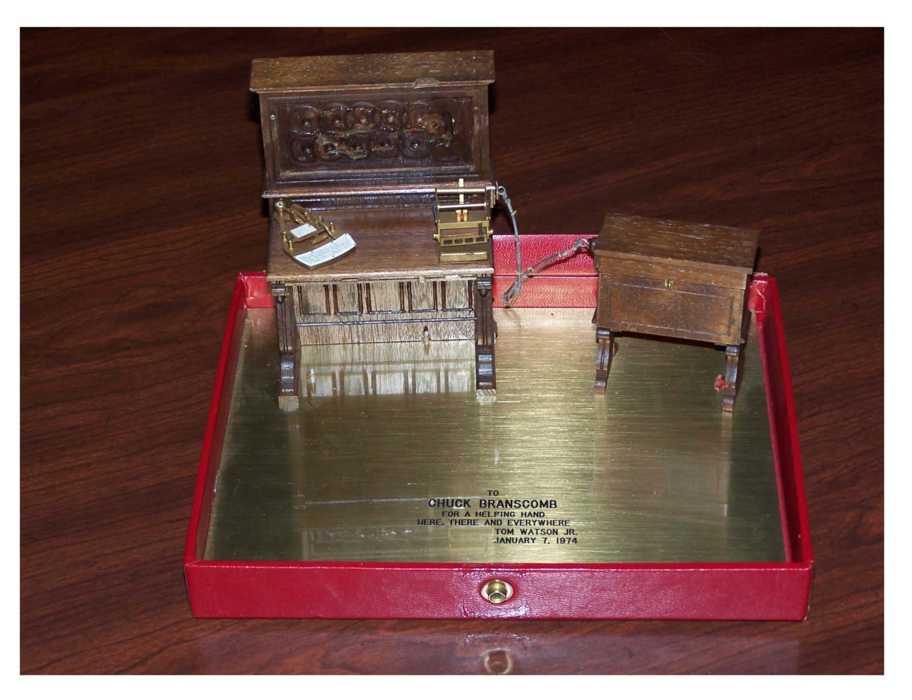
From Tom Watson Jr.
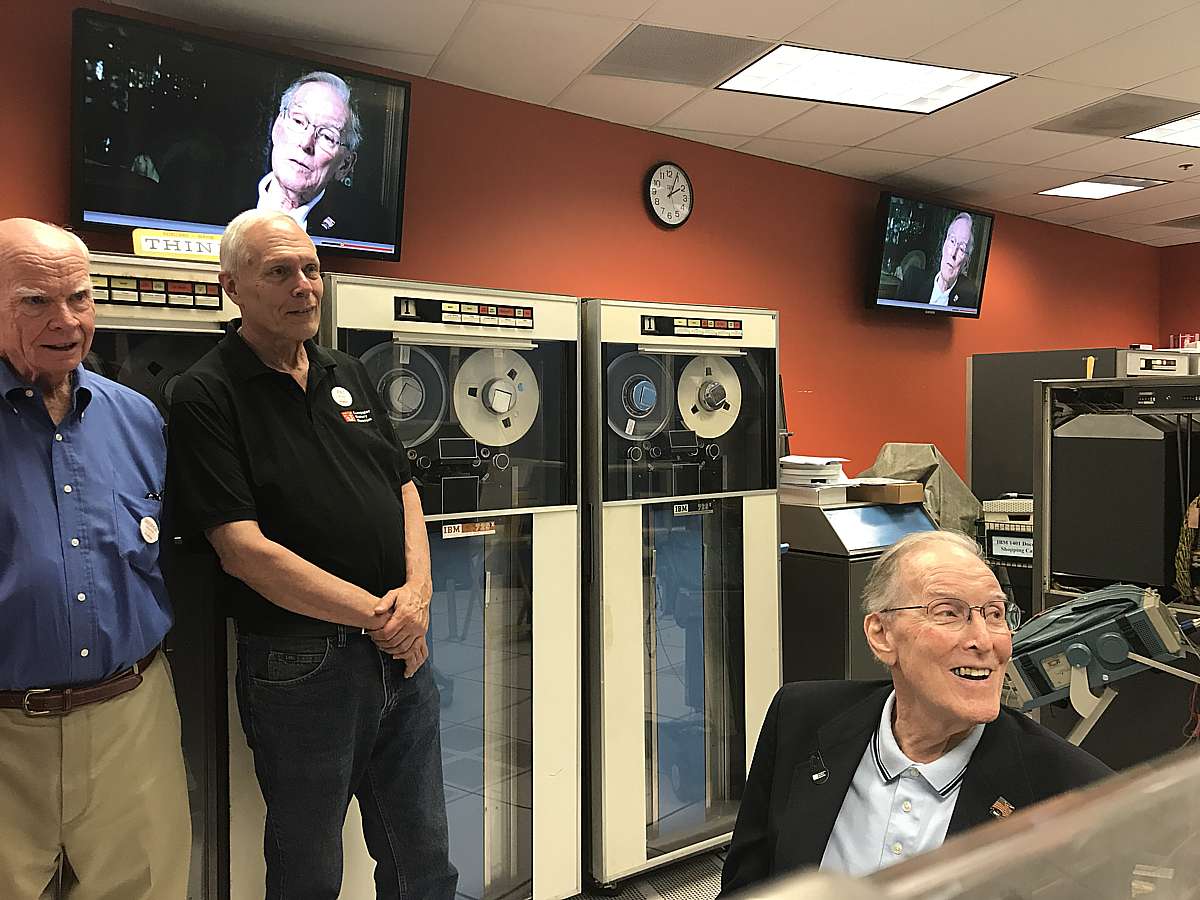
Visiting CHM May 2017
Quarter Century
Congratulations
from:
- Jonie Dayger
- Ralph Palmer
- Lewis Branscomb
- Frank Cary
- Fran Underwood
- Tom Watson Jr
- Spike Beitzel
Obituary
|
"1401 Program Manager"
|
Charles Branscomb's career at IBM spanned 39 years, where he developed and managed several successful IBM products, including the IBM 1401 data processing system, enterprise systems (System/360) and several mid-range systems. Charles joined IBM in the Endicott, NY lab in August 1950 to design punched card handling and unit record products. In 1957 he became Area Manager for accounting machines and directed the development of the IBM 1401. After various executive staff positions, in 1964 he became Director of Computer Assisted Instruction and in 1966, President of the Systems Development Division with eight US labs and six European labs, managing delivery and expansion of the System/360 product line. In 1971 he joined the Corporate Technical Committee investigating future technologies; in 1973 became Director of Engineering, Programming, and Technology; and in 1974 became VP Development and Manufacturing of the General Systems Division in Atlanta, responsible for Systems 32, 34, 38, Series 1, and the IBM PC. In 1983 he became VP of Telecommunication Systems in Communications Product Division in Raleigh. After his retirement in 1986, he consulted full-time to IBM for 3 additional years and then spent more than a dozen years volunteering at North Carolina State University with two adjunct appointments in its College of Engineering. Charles received a MSME from North Carolina State University in 1950.
|
I joined IBM in the Endicott, NY lab in August, 1950 after receiving an MSME from North Carolina State University.
After a brief engineering training program, worked on a new accounting machine in 1952. Then worked for Larry Wilson who
was developing new technology for all aspects of punched card handling and putting out new unit record products. I was
still working for Larry when in mid-1957 I was assigned as Manager, accounting machines. After assessing the WWAM,
I directed the development of SPACE, which led to the announcement of the 1401 in October, 1959.
I left the 1401 in Nov, 1960 to become AA to GPD Division President. Then went to San Jose lab as System Manager, Control
Systems, in August, 1961. Back to New York in March, 1963 to join staff of Group Executive who had several development
divisions ? including most involved in System 360 program.
I became Director of Computer Assisted Instruction in September, 1964 and then President of Systems Development Division
from March, 1966 to September, 1969 when I became Asst. Group Executive. In 1971 joined the Corporate Technical Committee
and in 1973 named IBM Director of Engineering, Programming, and Technology.
One day I received a call from his office saying Mr. Watson would like me to join him at his home for dinner. There were about ten of us (maybe more) from the technical side of IBM there, had a pleasant evening [January 7th 1974] and then Tom had a Hollerith model for each of us brought into the room. I?m surprised that I don?t remember just who was there but I believe Jack Bertram, John Gibson, Eric Bloch, Bob Evans, and Jerry Haddad were included. Tom said he wanted to make sure we understood how much he appreciated everything we did for IBM (of course he said this much more elegantly).
Spent approx. 7 years in GSD managing Development and Manufacturing before returning to New York in 1981, and then in 1983 to Raleigh, NC (back home) responsible for Telecommunication Systems. Retired in June, 1986.
his career with IBM,
An oral history - 2009, Main 1401 Story
added July 2009
He was named distinguished engineering alumnus of North Carolina State University (NCSU) in 1978 and, after retiring from IBM, spent more than a dozen years of heavy volunteering at NCSU with two adjunct appointments in the College of Engineering. He was awarded the Watauga Medal which is the highest recognition NCSU gives their volunteers.
p.s. ... I had an extremely enjoyable second career at NCSU which I have summarized briefly. ...
IBM Career
Charles E. Branscomb
Joined IBM in August, 1950 after getting my BS & MS degrees in Mechanical Engineering from N.C. State.
After 4 months in engineering training program, assigned to new accounting machine development ? Transcriber. Later terminated because of complex mechanisms required and limited printer speed.
Assigned to Larry Wilson?s team focused on new technology and products to handle punched cards. Larry was a statistician who joined IBM from the census bureau to build a special card "sorter". He was very creative and has a great "feel" for good design ? he always said that when you get the right design, it will be simple, easy to build, low cost and reliable. He became not only my boss but my mentor. Much new technology and many products came from his team.
Early 1957 assigned as manager of accounting machines. WWAM program underway in European Labs. After assessment of WWAM, turned attention to what became the 1401. Directed develop[ment of 1401 from the time there three people on program until it was in production.
November, 1960, named Administrative Assistant to division President.
August, 1961, named Systems Manager of Control Systems in San Jose Lab.
February, 1963, assigned to Group Staff reporting to John Opel (who later became President of IBM). We served Group Executive Vin Learson who had several development divisions most of which were focused upon Sys. 360 developments.
September, 1964, Named Director of Computer Assisted Instruction. Put out IBM 1500 (small computer with 10 student station capability) for use by researchers in CAI. IBM had about 150 people working on CAI and established research activity with about 8 major universities.
March, 1966, Named President of Systems Development Division with eight US labs and six European labs. Many challenges in System 360 hardware and software as well as the Time Sharing System (TSS).
September, 1969, named Asst. Group Executive.
1971, named member of Corporate Technical Committee. Great change of pace since we spent all our time looking into the future ? technologies (hardware and software), systems, sub-systems, and applications.
1973, named IBM Director of Engineering, Programming, and Technology.
1974, named VP of Development and Manufacturing in General Systems Division (located in Atlanta, Ga). This integrated division re-established IBM?s leadership in small to medium systems ? Sys. 32, Sys 34, Sys. 36, Sys. 38 (later with enhancements became A/S 400), Series 1, and finally the IBM PC just before it was reorganized back into other divisions.
1981, named Asst. Group Executive (back in New York).
1983, named VP, Telecommunication Systems in Communications Product Division (Finally back home in North Carolina). Named Corporate VP of IBM.
June, 1986, retired from IBM after 36 years. Actually continued essentially full time consulting for three years after I retired ? much of the time in the PC area.
|
e-mail April 19, 2013 - our $2500/mo target for the base 1401 system.
Robert
Since I did not retain any of my 1401 development note or correspondence, I cannot give
you specific "facts" to support our $2500/mo target for the base 1401 system.
My recollection is that the target was initially suggested by Fran from his experience
with unit record customer installations. I used my own experience from the MRU Army
installation where I worked. Following is the approximate profile of our office:
3 024 Keypunches, 2 085 Collators, 2 512 Reproducers, 1 Interpreter( do not know #),
3 080 Sorters, 2 405 accounting machines. I do not know the rental value of any of
these machines but I felt in 1957 that a 1401 base system starting at $2500 would be
very attractive for this installation. Our prime application was processing
"morning reports" from all units in Korea each day and producing an updated data base
on the 36,000 GI's in Korea each morning. When I first joined the unit, they were
operating most of three shifts to achieve this result. My thought process attempted
to focus on the customer's installation and applications rather than just the hardware
(and plugboards).
Of course, Fran's experience was with customers in the 1950's when they had
088 Collators, 083 Sorters, 514 Reproducers, 402/407 Accounting Machines,
and many a 604 Calculator.
Market planning had some of this kind of information from the WWAM studies but my
recollection is that it was not specific enough to profile "typical" installations.
After Shel came on board, he proceeded over a period of time to get much better
profile information for both equipment and applications that supported $2500/mo
as a very good target for the entry system. The large unit record installations
had installed 650's and/or 705's and were not our prime focus.
I would also emphasize again that, in addition to the monthly rental, simplicity
and ease of use was an extremely important focus since almost none of the thousands
of unit record users had any experience with stored program computing. I should
also note that many installations had a lot of printing - well beyond the feeds
and speeds of the punched card machines - so the 600 line per minute 1403 was
extremely attractive.
Since most of the above represents merely my recollections, I suspect it is not
too helpful in providing the "facts" that supported the target rental.
Chuck
|
50th Anniversary, CHM
- Charles Branscomb starts 13 minutes in :-))
On Dec 16, 2017, Chuck Branscomb wrote to Robert Garner:
It is with great sadness that I'm reporting the passing of my father, Charles E. Branscomb,
[after an infection following surgery] ... he simply could not get the best of it.
He passed peacefully and comfortably this morning, the 16th, at 5:30am with family by his side.
Obituary
Could you please inform the larger 1401 and museum community of which he has held so dear to him?
The past almost 10 years of interacting with you, the museum and former colleagues
and friends from that special time so many years ago was incredibly fun, intellectually
stimulating, and so rewarding for Dad to have experienced. I'm so glad that we were
able to help him visit the Computer History Museum again this past May. He especially
enjoyed interacting with the 1401 tour crowd, answering questions, etc. It was a very
special time for him. He greatly appreciated all the interaction with you through
the years and was looking forward to continued future interaction (especially on
the subject of education). Dad had just so much enjoyed seeing Jud McCarthy here
in Raleigh a week ago Monday just prior to becoming ill, so I'm sure this will
come as a complete shock to Jud.
Best regards,
Chuck Branscomb (aka little Chuck ;) )
|
from Jud McCarthy, Dec 17, 2017
To: All: I am so sorry, but glad to have had the recent opportunity to spend a few hours,
including lunch, with Chuck and my lady friend Rose at Chuck's apartment
complex, less than two weeks ago. He was in good spirits, quite mobile, and
looking forward to continuing his interactions with NC State.
Like you all, I will miss him dearly, and the yearly visits
that we have shared over the past number of years. First Jim Ingram now Chuck.
My future visits to the Cary / Raleigh area will be somewhat less enjoyable,
but I will never forget our 1401 brotherhood.
FYI: I have attached a couple of pictures taken on the
subject visit. At least the picture of Chuck is especially nice. ------ Jud
|

Chuck Branscomb
12-04-2017
|
|
Berwin Darrow - 
(H) (607)-748-7102
(C) (607)-239-1050
"Bob was responsible for the 1403 hydraulic carriage in the product engineering phase of the program. I told
him about [your] hydraulic oil problem."
|
Gene Darrow - Darrowehdeld@aol.com
| This is a 1963 announcement picture of Gene Darrow as Manager of Printers,Product Engineering.
| 
| This is a 2002 picture of Gene Darrow.
| 
| This is a 1055 picture of another Endicott Printer Program showing Otto Moneagle (deceased) front row,2nd from left. Otto was heavily involved in the design of the chain for the 1403 Printer.
| 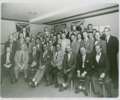
| This is a 1982 article about Gene Darrow published in the IBM Raleigh Site Bulletin. It describes Gene Darrow's 30 year tenure ( in 1982 ) on Printer Products Programs. It also shows Gene at his desk with parts from various printers he worked on. Also shown is Gene examining a 1403 chain belt with one type slug assembled to it.
| 
| This is a 1963 organization chart for Product Engineering. I believe that the 1403 Printer responsibility was transferred to Product Engineering at this time with Gene Darrow as the manager.
| 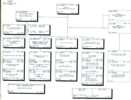
| This is a 1973 picture of John Drejza presenting Gene Darrow his 25 Year Club Certificate.
| 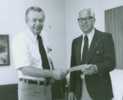
| This is a 1952 picture of an Endicott group from another printer program having a social evening with their wives. Gene Darrow is shown in the back row,4th from the left. Chuck Branscomb is shown in the back row, 6th from the left.
| 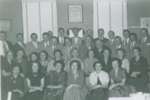
| .
| .
| | | |
- EUGENE H DARROW'S BIO. [as of 2009]
- Age- 83
- IBM Serial No.- 522290
- IBM Service- July 1,1948--May 31,1987
- FAMILY
- Wife Eleanor (deceased in 2008)
- Daughter,Joan,New York City,NY
- Son,William,Fairport,NY
- EDUCATION
- 1947-Batchelor Of Science-Rennselaer Polytechnic Institute
- 1948-BSME-Rennselaer Polytechnic Institute
- IBM CAREER
- Hired July,1948 for customer engineering training
- Oct. 1948-Nov. 1951
- Assigned to the Washington DC office as a Customer Engineer
- Nov.1951-Sept. 1954
- Transferred to the Endicott Development Lab. First assignment was to assist on the design and release of the 407 Label Writing Device.
- Sept.1954-Sept. 1959
- Manager to assist in the development, release,and product engineering of the 720, 720A, and 730 Wire Printers.
- Sept.1959-May.1963
- Worked with the 1403 Printer development group on the models 2 and 3.Manager responsible for release to production and manufacturing interface.
- May 1963-Jan.1967
- Manager of Product Engineering for 1403,1404,1403 N1 and misellaneous Printers (402,403 407,etc.).
- Jan.1967-Jan.1969
- Assisted with the mechanical development of the 22FP Printer.
- Jan.1969-Aug.1972
- Assigned to the Printer Products Engineering Planning group. Assignments included writing Engineering Specifications for the 5203,5213,3215,2222,2213 as well as interfaceing with the Printer user groups.
- Aug.1972-Feb.1975
- Assigned to the LYNX D Printer development group as manager of plans and control. Responsible for plans,budgets,LYNX documentation, parts ordering,early system hardware requirements,and interface activity with all LYNX using systems.
- Feb.1975-Apr.1976
- Manager of the LYNX D Printer development program. Responsible for the mechanical
and electronic design,test and release.
- Apr.1976-Apr.1977
- Assigned as manager of Product Engineering for all LYNX printers.
- Apr.1977-Aug.1978
- Assigned to the Printer Products Planning group responsible for the engineering planning for the Nagold 1 Printer along with staff and technical duties as required to assist the Printer Products Products Manager.
- Aug.1978-Mar.1979
- Assigned to the technical staff of John Keffer,Printer Products Product
manager.
- Mar.1979-May.1980
- Transferred to Raleigh N.C. as Product Engineering manager for the 3287,3289,3767,and3288 Printers.
- May 1980-Apr. 1981
- Mechanical Packaging and release manager for the TAMA Printer program.
- Apr.1981-Sept.1984
- Mechanical development manager for the 3268 Printer.
- 1984-1985
- Manager for mechanical development for the 4214 Printer.This involved outsourcing the development to a vendor in New Hampshire.
- Jan.1985-june1985
- Responsible for the transfer of all of raleigh printer development and Product Engineering to Charlotte.N.C.
- June1985-June 1987
- Assigned to a communication product which ultimately became the 3748. My responsibility was to act as liaison between Raleigh,Boeblingen,Germany and France.This involved a 6 month assignment in Boeblingen.
- May 31,1987
- Retired after 38 years with IBM, 35 of which involved Printer Products.
|
John Drejza info from Gene Darrow
Karl Ganzhorn
Prof. Dr.rer.nat. Dr.-Ing. E.h.
Karl Ganzhorn
|
Gluckstr. 1, 71065 Sindelfingen
Tel.: 07031-812022 /Fax:-812024
e-mail:Karl.Ganzhorn@t-online.de
|

|
CURRICULUM VITAE
(Abstract, Status 3/2007)
Born: April 25, 1921 in Sindelfingen, Germany. Married, 2 Sons.
Professional Education: Physics, (PhD in Theoretical Physics, Univ. Stuttgart, 1952).
Professional Career:
IBM Germany (1952 - 1986),
Member of the Management Board of IBM Germany (1963 -1986),
Honorary Professor at University of Karlsruhe, Information Technology (1960 - 1987).
International Career in IBM(additional):
Director of IBM Laboratories Germany, Austria and Sweden (1963 - 1971),
Member of the (corporate) IBM Science Advisory Committee (1972 - 1975),
Director for Science and Technology in IBM Europe (1973 - 1975),
Vice President of IBM Systems Communication Division (1975 - 1978).
External Scientific Appointments:
President of the German Physical Society (1969-1971),
Member of the Science Council of the Federal Republic of Germany (1978-1987),
Member of the Executive Committee of the European Physical Society (1971-1973),
Chairman / Member of the Advisory Boards of 3 Max-Planck-Institutes:
MPI Heisenberg Inst. Physics, Astrophysics, Exterrestrical Physics Munich (1972-1991),
MPI Metal Research Stuttgart (1965 - permanent Hon. Chairman),
MPI Solid State Research Stuttgart (1975-1989)
Member of the Advisory Board at the Ministry for Science and Arts,
Bavaria, Munich, (1987-1993),
| Member of United Nations
"Advisory Committee for Science and Technology for
Development", New York (1987-1992).
|
External Industrial Appointments:
Member of the Board of Directors of
- DIN, German Institute for Standards (1980-1985),
- MAN Roland Druckmaschinen AG Offenbach/ Augsburg (1984-1992),
- LENZE AG El. Drive Technology, Hameln (1986-1997).
|
Science/Technology Advisor of the General Management of TÜV (Techn.Supervisory
Agency) Baden/Wuerttemberg (1989-1996)
Personal Appointments:
Dr. honoris causa, University Stuttgart (1978),
Comptour Cross of the Federal Republic of Germany (1982),
Honorary Senator of the Technical University of Munich (1982),
Fellow IEEE, Institute of Electrical and Electronic Engineers, New York (1987),
Golden Honorary Medal of the City of Sindelfingen (1992).
15 Books (9 as Author / Co-Author, 6 as Editor)
74 Scientific Publications,
49 Patents.
|
John Haanstra - after 1961
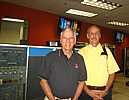
Left is Robert Garner,
Right is Bruce Haanstra, son of John Haanstra
|
From Charles E. Branscomb, 1401 program manager, who knew John Haanstra
Robert
I assume you recall my story about John from the
"1401 story". In early 1961 when I had moved to division HQS, John was division VP of Development. He asked me to go with him on a Friday visit to the Kingston, NY Lab (about 2 hour drive) and all the way up and back he probed me on how the 1401 handled Input/Output. Monday AM his secretary called me what I did to her boss on Friday. After the weekend John had showed up with some 14 to 18 Executary "belts" (The IBM OPD recorder used belts instead of tapes giving random access to recordings) to be transcribed. They represented the design of a multiplexor front end for the 1401.
John was not only a powerhouse intellectually but he was powerful physically as well. I still vividly remember being in a meeting with John and the VP of Manufacturing for the division (Bud Thue) where John was demanding that 1401 production for the first year be doubled. He had a habit of cupping his hand and pounding on the conference table - I believe the room actually shook when he did that. John won and production was doubled.
You have got some good insights into the Development area activity after Honeywell announced the H200. It is unfortunate that Jim Desell is no longer living. Jim was Systems Engineering Manager in the Eastern Region when H200 was announced and he could have personally provided the Marketing division activity. When he found out that Endicott engineers were skeptical that Liberator would work, Jim found a way to get into a Honeywell customer demonstration and saw that he did in fact work. He then went to Endicott to make sure there was no misunderstanding and demand that development respond. I was on Vin Learson's staff while this was going on and remember interacting with Jim about H200 and Liberator but I do not remember the specifics.
About a dozen years later Jim and I became very good friends in the General Systems Division where he was head of Marketing and I was head of Development and Manufacturing. As I think you know GSD re-established IBM leadership in the middle to low end of the product line. I read recently that IBM world wide sold over 250,000 System 32/34/36/38s.
I did not mean for this to get so lengthy - I hope some of it is of interest to you.
Chuck
|
Ingram, Jim - jim-i (at) att dot net

1401 Project Manager

At CHM 2009
| Joined the Endicott, NY Lab of IBM in Feb, 1950 after obtaining an MSEE from Purdue. Worked on the IBM 650 Magnetic
Drum Data Processing Machine, from early development through early production stages, responsible for the magnetic
drum circuits. Also did several short term planning/circuit design assignments on ways for IBM to use electronics in other areas.
Starting in late l954, led an engineering group seeking to develop machines for card processing, accounting,
and card and printer I/O for large computers. Participated in the WWAM meeting in Germany from late May through early
July, 1955. In mid 1957 was assigned to the 1401, then in its early planning stages, and as the program progressed
became the project manager. Left the 1401 program in late 1962 after a significant number of machines had been
shipped and programs to add additional functions, including Additional Memory and adding the 729 magnetic tape drives
and the 1405 hard disk drive, were completed or well underway.
In early 1963 worked for IBM's Nordic Lab in Sweden as manager of the 1070 Process Communication System.
This system was transferred in early 1964 to IBM's San Jose Lab, along with several of the Nordic Lab engineers.
It was announced as part of the 360 announcement in April, 1964, and shipments started about a year later.
In early 1966 moved to IBM's Raleigh Lab as Plans and Control manager. Worked on development of IBM's
Point of Sale equipment from 1969 until retirement in 1987.
Jim passed away November 12, 2015 -
obituary,
(local copy)
|
Jacobs, Shel

"1401 marketing lead"

"Dawn of a New Era"
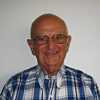
2009
|
|
Sheldon Jacobs' career at IBM spanned 38 years, where he was a Planning Manager for many successful midrange computing products. He joined IBM as a Sales Representative in the Chicago Downtown sales office in 1952 and moved to Endicott, NY in 1957 as a planner for the IBM 1401 Data Processing System, where he established preannouncement field case studies and classes and played a critical role developing a business case to support the 1401's announcement. In 1960, he took a Planning Manager position for midrange products in San Jose, including the early development of the 1401-compatible IBM 1440 Data Processing System. In 1962 he became a consultant in Corporate Marketing in Armonk, NY evaluating low-end products and outside proposals. In 1965, he returned to San Jose working on products for new markets. He then did various planning jobs for Direct Access Storage Devices (DASD), including the IBM 3340. In 1982, when IBM was hit with law suits by competitors, he was assigned as Litigation Support Manager in the General Products Division. He retired from IBM in 1990 and spends his time doing a variety of volunteer activities. Shel graduated from University of Illinois in 1952 with a BS in Accounting.
|
I joined IBM in 1952 in the Chicago Downtown sales office. I moved to Endicott in the Fall of 1957 as a planner in the Glendale Lab. Shortly thereafter, I was assigned to an advanced accounting machine project. It evolved into the SPACE program, Stored Program Accounting and Calculating Equipment, which was announced October 5, 1959.
I became the Planning Manager responsible for the business aspects. I did field case studies to help finalize the design objectives, set up preannouncement classes to get reactions and suggestions from IBM field personnel. I spent a lot of time negotiating the five year forecast which was pivotal in developing a business case to support announcement. As announcement neared, I worked with marketing in preparing for the 1401 announcement via the first national closed circuit TV release.
After announcement, I was transferred to San Jose as the Planning Manager for Unit Record Systems and charged with making sure the 11LC, eventually announced as the 1440, was programming compatible with the 1401.
In 1962 I joined Corporate Marketing in Armonk evaluating low end products and outside proposals. I returned to San Jose in 1965 doing various planning jobs in DASD. When we were hit with law suits by our competitors, I was assigned as GPD Litigation Support Manager. I managed the document reviews by the plaintiffs within IBM as well as our reviews of their documents at their locations. A major challenge was explaining the IBM culture and products to our attorneys.
I retired in 1990 and spend my time in a variety of volunteer activities.
|
in April, 2013, there was considerable question about how the target rent or lease of the
upcoming 1401 was set at $2500. Chuck Branscom answered here and
Robert Garner as Shel this "
Shel --> Do you recall how the $2500 target was set? " below is
Shel Jacobs' answer."
Robert,
I visited many accounts and focused on those that were running out of capability to keep up with the demands of their unit record equipment and were faced with adding another tabulator. These accounts usually had 3 403s or 2 407s with summary punches and a single calculator - either a 602A or a 604. The 403s were in the range of 500 points and the 407s were about 800 points. I don't remember the points of the punches or calculators but the installations started in the 2000 to 2200 point realm. The target of $2500 was a more attractive alternative to adding another tabulator since it took up less space, offered faster card reading and printing. It also had the potential of requiring fewer operators. The target also considered the competitive alternatives. I can't recall what was already announced there were some heavy hitters trying to get into the market. I remember Remington Rand, GE, and RCA.
I made extensive use of our account profile inventory lists. I could find out how many accounts we had by the number of tabulators and calculators. I was able to identify market potentials by installation point size. I used this data to create a planning estimate of the of the forecast which was the basis I used in challenging the low pre-announcement forecast.
I'm sorry I can't be more specific but too many years have gone by.
Shel
|
50th Anniversary, CHM
Shel Jacobs starts 1 hour 30 minutes in :-))
|
Shel Jacobs passed away Feb 5, 2019.
Obituary
Robert Garner writes:
"I, like so many, was deeply touched by Shel's funny, wry, delightful and infectious sense of humor, emotional intelligence, and enthusiasm. He will be sorely missed."
|
|


| The marvelous software [AutoCoder and FORTRAN] 1401 team that I led consisted of:
- Stan Smillie, a teenager that I found at the Bronx High School of Science
- John Wertheim, whom I began training at Republic Aviation
- Gary Mokotoff whom I recruited from another group at IBM
- Len Haines, a mathematician, who first proposed doing serial compilation on the 650.
- and myself, with ten years of programming and systems experience,
at the time: CPC, 650, 650 RAMAC, SOAP (an optimizing assembler)
an e-mail received May 02, 2015
Hi, all,
I'm still here, at 97, with an Android smartphone.
I was very active in APl and APL2,
having edited the APL Handbook of Techniques.
I enjoy teaching 'problem-solving' to young people.
My first product was a general-purpose CPC control panel
for the engineers at Republic Aviation, in 1951.
|
Don Manning w photos - dmanning8 at stny dot rr dot com
| no photo of Don yet
| preliminary, unofficial info
| 1403 - mod 1&2
| 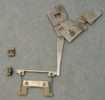


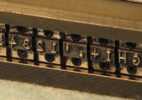
| 1403 - mod 3
| 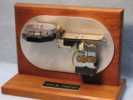
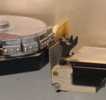
| |
Got to thinking -- my cartridge may be a development prototype - I don't really know. A lot of my parts are various development pieces - never got released.
- Back Printers (drive paper into ribbon/type)
- 1403-1/2 600 lpm w/48 character set
- chain velocity - 90 "/sec
hammer velocity - 107 "/sec
parallel motion - hammer on two leaf springs - actuated directly by armature
casket on pedestal
- 1403-3 1100 lpm w/48 character set
- train velocity - 206 "/sec
hammer face velocity - 210 "/sec
pivoted hammer actuated by armature through a pushrod
casket on a pedestal
- 1403-N1 1100 lpm w/48 character set
- same as 1403-3
fully enclosed (except for rear paper access) for improved acoustics
- Front Printer (drive type into ribbon and paper - typewriter like)
- 3211 2000 lpm w/48 character set
Then later many more back printers using a band instead of a chain or train.
I came into the 1403 design and development department in 1/1958. The 1403 was already well underway at that time. I got to assist with hammer unit, print quality, ribbon smudge, stacking, etc. evaluations/improvements prior to and during Product Test phase. The people involved were (as I remember):
- Jim Troy - Glendale Lab Mgr - Endicott, NY
- Jonas Dayger - Printer Products Development Mgr. (several serial and line printers were in development)
- J. Mason Cunningham - 1403 Development Mgr.
- John Drejza - developed hammer unit and probably more (later did the Tape Lister development for these printers)
- Otto Moneagle - lead cartridge engineer plus other stuff like stacking paper
- Al Dowd - swing casting, translator frame, ribbon guide
- ??? - tractors (maybe Otto), forms drive
- ??? - hydraulic unit
- several people on covers, control panel, etc.
- Electrical manager was Fred Shaff (I think). Printer itself had no printing logic (I guess we said it was a slave).
After the 1403-1/2 was announced and primary control was shifted to Product Engineering (Jim Walsh, Gene Darrow, etc.) our group started on the 1403-3 in earnest. That is when I became the lead engineer on the 1403-3 hammer unit. Don Rose designed with me. Actually I designed and built the first train (it was a 3 array, 48 character set unit that I actually still have). Due to worries about ribbon fiber build up between the slugs we opted for monorail/chair style slugs that we actually used. The same managerial people were involved.
I myself stayed in printer development in Endicott until I retired in 1993. Lots of opportunities to relocate to Raleigh, Charlotte, Tucson, San Jose, Boulder, etc. Family was here and I still like the place!
a list of Don Manning's 1403 Ref Material
|
McCarthy, Justin - deceased, 29 Dec 2022



with prototype 1401

at CHM
|
I was a member of the 1401 Product Development Team. I was involved in the development of the first transisterized units in the Endicott Glendale Lab - the PECU (Print Edit Control Unit) & TAM (Transister Accountng Machine) prior to the 1401 team being pulled together under Chuck Branscomb.
(July 2020)
Jud has authored a book of his experiences with IBM. It is
Light Blue: An Entry Level and Mid Management Perspective of IBM's Evolution Through the Golden Years,
available now.
During the pre-1401 era, I worked for George Mitchell, and Claud Pyle under Jim Ingrahm. When the 1401 team was pulled together under Chuck, I worked first for Rus Raleigh and then Joe Conzola under Jim Ingrahm, who inturn reported to Chuck. Although I never reported directly to Francis O. Underwood, I worked closely with him & his department and kept in touch and visited him when he moved to Los Gatos, where he became Father of The Floppy Disk Drive on his little educational system.
I have names and org charts from even back then. Although, always a peon at the bottom, I always felt as one of the important team members. We all worked 3 rotating shifts, 6 days a week, and seldom, if ever, complained. I was involved with the 1401 base design, debug, and release to manufacturing in Endicott. Like John Pokoski, I worked in Building 41 supporting manufacturing build, debug and shpments of 1401 customer shipments. I spend almost a year in San Jose as a 1401 base system support person during the development and release of the 1405. I also spent my share of time supporting IBM CE's in the field, before joining the 1440 / 1460 / 360 Model 30 groups.
I have so much 1401 memorbilia in the crawl space up stairs, and plan to bring it all down someday when I retire and write down my IBM experiences. I will gladly share any / all with you and the team in CA. I have loged the date of 9/22/2009 in my little book, and plan to be there even if you guys won't let me in. John Pokoski and I have discussed getting the old 1401 development team together for many years, and now we have purpose.
Although I live in Boca Raton, FL, I really want to handle pullng those, still available, together for such a gathering. An example is George Ahearn, who I hope is still alive, and right under your nose in Los Gatos. Incidentally I worked for George during my stay in San Jose working on the 1405.
Jud McCarthy generated a more complete staffing document.
Justin sent the following, which is being parked here for safe keeping until further processing
In 1956 we all in Dept 280 (including Dick Case) were working on
the first units to incorporate transistors into new units that were
considered Unit Record (ie: 407) replacements. One was called PECU
(Print Edit Control Unit) and another was TAM (Transistor Accounting
Machine). In the workers eyes, Fran Underwood's SPACE (Stored
Programming Accounting Calculating Equipment) architecture, and the
transister work on TAM folded together to become the 1401. This would
be better addressed by Fran, Jim Ingram, and Chuck Branscomb, as I was
so mired in the details that my perception may be some what off base.
However, most of us working on the TAM unit, moved to the 1401
development team, somewhere around mid 1957. Some of the engineers
transferred to the 1410 and some moved to Poughkeepsie. I lost track
of Dick in 1958. Jim Ingram may have additional details, as I believe
Dick reported through the chain of command to him.
|
also
Robert, George, Guy et al: When I joined IBM at the Endicott Glendale Lab on June 4, 1856, it was already a foregone conclusion that all new development systems and devices were to be basically designed using transistor logic.
I joined Dept. 280 that was the main system design group, and half of the group was working on a PECU ( Print Edit Control Unit) designed in tube logic and ready for release to manufacturing. The other half of the group was delving into fundamental circuit design using PNP GE transistors. This was the group I was assigned to.
The next group over the wall, was a small group with Fran Underwood laying out the architecture that was to become the 1401 with the self mandate to use transistors.. Down the hall from us was the last announced model of the 650 System completing final testing and in the process of being released to manufacturing.To my knowledge, it was the last system or unit designed in IBM with tube logic to make it to manufacturing.
Shortly after I joined Dept 280 the PECU was killed, even though the design and testing were complete. I am quite sure it had not been previously announced.
Regards ----- Jud
|
Jud is featured in the “A Century of Smart: The IBM 1401” video at 0:15, 0:24, 2:16, and 4:15.
https://www.dailymotion.com/video/x2yuzuv [requires disabled AdBlocker]
At 4:15 he proudly says: “I worked 53 years, straight. The most time I ever took off was two weeks. I never missed a full day of work — ever. I missed two half days. Personally, that’s my proudest."
|
Mokotoff, Gary - gary at mokotoff dot net ,

Group Picture
|
I joined IBM in June 1959 and was immediately assigned to the 1401 team. One of other members, I think it was Bernie Silkowitz (co-creator of RPG), gave me the (typed) programmers manual and said "If you have any questions, don't ask us, because we don't understand it either." My first program was to write a utility that printed out memory. I learned programming by following a program that already existed and I followed the machine-language instructions and that is how I learned to program.
My first programming application was to write multiply and divide subroutines in machine language because multiply/divide hardware was an optional feature in the initial announcement of the 1401. I then wrote SPS-1 and then SPS-2. John Wertheim and I then wrote 1401 Autocoder and then a team of people wrote 1401 FORTRAN.
The group was broken up in 1961 or 1962. I went to an IBM think-tank type group and was drafted into the Army in January 1963. After completing basic training at Fort Dix, New Jersey, I was assigned to the data processing department at Fort Dix where I remained for the duration of my Army carreer. They had IBM 407 accounting machines with plans to install a Univac 1101. The 1101 was a disaster. I realized that technically it was not a computer because it could not simulate a Turing machine. When they heard I had 1401 experience, they cancelled the Univac and ordered the 1401. I wrote most of the programs for the base (lots of interesting stories; made SP-5 in two years).
I don?t ever recall programming for a disc 1401 but did use card and tape systems.
Gary donated the original source code for SPS1, SPS2, Autocoder and FORTRAN to the
Charles Babbage Institute.
During an e-mail exchange amongst many folks, about IBM card usage -
Gary wrote:
| This dialogue reminds me of an old IBM joke:
Do you know how they buried Tom Watson Sr.?
Answer: Face down, nine edge first!
|
|
Palmer, Jack - deceased -
Papo, Maurice - died April 2021 as per
https://ethw.org/Maurice_Papo
MAURICE PAPO
Education
Dr. Maurice Papo graduated in France from "Ecole Polytechnique" (1951)
and "Ecole Nationale Superieure des Telecommunications" (1954).
He also holds shorter course degrees from Brookings Institute Washington, INSEAD-Stanford, and Centre des Hautes Etudes de l'Armement
IBM
He worked 35 years in IBM executive positions in France, Europe and the USA, primarily R&D Director, but also World Director for Standards, World Director of Product Line, Director of Commercial Relations, Industry Relations and Patents, and chief Scientist. He established and managed a new IBM R&D Laboratory in La Gaude, France. Most of his R&D work has been in the fields of Computers and Telecommunications in which he has held a significant number of international patents. He has participated in most IBM strategic and organizational studies involving its multinational evolution.
After retiring from IBM he worked as independent senior consultant. He has been very active in the Executive Boards of National Engineering Societies, has founded and chaired several National Engineering Societies, was Vice Chairman of the European Industrial Research Management Association, and member of several Universities Scientific Advisory Boards.
IEEE
Vice-President Regional Activities (Member of the Board of Directors and Executive Committee)
Chair of RAB Nominations & Appointments Committee
Chair IEEE Nominations & Appointments Committee
Chair of the President's Consult Group
IEEE Secretary (Member of the Board of Directors and Executive Committee)
Member at Large Education Activities Board
Member at Large Publication Activities Board
Director Region 8 (Europe, Africa, Middle-East)
Chair France Section
Awards
IBM Outstanding Invention Award
IEEE Fellow1987
IEEE Millenium Medal
IEEE 2000 Larry Wilson Transnational Award
IEEE Haraden Pratt Medal
"Officer" grade in the French Legion of Honneur for outstanding services to the Nation
"Commandeur" grade in the French "Ordre National du Merite
"Commandeur" grade in the French "Palmes Academiques" for outstanding services to the National Education)
"Knight" grade in the Monaco "Saint Charles" Order
Short Form
Mr. Papo graduated in France from "Ecole Polytechnique" and
"Ecole Nationale Superieure des Telecommunications", as well as from the
"INSEAD" in Fontainebleau and the Brookings Institute in Washington. He joined IBM in 1954 and worked 35 years in executive R&D positions on both sides of the Atlantic ocean, with responsibilities in France, Europe and the USA, including the setting-up and management of the IBM France R&D Laboratory in La Gaude near Nice. He has also occupied international IBM position in the management of Product Line, Marketing and Standards. Most of his R&D work has been in the field of Computers and Communications in which he has held more than 75 international patents. He has now retired from IBM and is working as an independent consultant. He has been frequently retained in Monaco where he has consulted for the Princess Grace Hospital, the Police, and the Palace of HSH Rainier III. He has been very active in the Executive Boards of National Engineering Societies, has founded and chaired several Regional Engineering Societies, and was Vice-Chairman of the European Industrial Research Management Association. He has also been a member of several Universities Scientific Advisory Boards. He was Vice President Regional Activities and member of the Board of the Institute of Electrical and Electronic Engineers.
A Meeting
On October 22, 1973 an exceptional IBM event took place. A meeting of
the joint IBM boards: Corporate and World Trade outside the USA: in France !
Through almost unbelievable personal relations, our President and CEO
Christian de Waldner was able to obtain the organisation of a gala
dinner and music in the Versailles castle! You will see in the attached
that the dinner had to be with gold dishes only for security reasons,
Versailles was not equipped with fire detection and no cooking/heating
material allowed.... There was no bus transportation planned, the
members of the IBM France executive committee each used their private
car for our guests. You may be shocked to learn that the lady in my car
asked why we went so far from Paris for a cold dinner !
|
Pokoski, John - johnpokoski at comcast dot net

1959
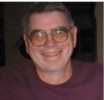
2009
|
IBM BACKGROUND
My first job out of college (June 1959) was on the 1401 project at Endicott's Glendale Lab.
Fran Underwood was my immediate supervisor and Jim Ingram "held my card". At that point, the basic machine had been designed but the optional features were still on the drawing boards. The first engineering model was in the process of being constructed and debugged. I was green as grass and my very first assignments involved learning the system, drafting, and technical writing.
Soon I was involved with debugging the system, particularly the second model, which also included optional features, and generating the necessary engineering changes. My prime responsibility was "expanded arithmetic" (multiply/divide). Later, I was involved with M/D redesign and testing, and other options such as process overlap and Sterling arithmetic.
I generated documentation for the manual writers and taught several classes for customer engineers. As the system progressed, I mentored the testers on the 1401 lines in Endicott (North St.) and later helped the production line get started in San Jose. I also made numerous field trips to aid customer engineers stuck on tough bugs and to install major engineering changes.
After three years on the 1401 I spent a year on development of an optical card reader after which I left IBM for academia. This was an exciting time in my professional life and the wide range of experiences that I had at IBM was invaluable to me in my teaching career.
BIOGRAPHY
1401 Memories-Endicott
A selection of 1401 development letters and org charts
More info about people in "A 5 minute video of the Old IBM and the IBM 1401"
on the first page of this web site.
" The handsome blonde guy who said, "I am an IBMer" at the end is Paul Farbanish. (He just turned 90 last week.) The round-faced guy with black hair and beard is Tom Schappe, who worked on I/O. He and I went to college together at St. Louis University, came to Endicott by car together, and were roommates for three years, until we each got married. There were about six other young engineers and draftsmen on the project who, with us, hung out socially a lot. Picnics and waterskiing at Cayuga, softball and basketball teams, partying, drinking, etc. Those alive are still in touch."
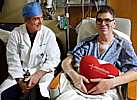
2016
|
from http://www.seacoastonline.com/article/20160124/NEWS/160129525/-1/ARCHIVE
HEART-WARMING STORY
Teamwork saves man from sudden cardiac arrest
78 year old collapsed playing basketball
Cardiothoracic surgeon Dr. Robert Helm talks with patient John Pokoski. Pokoski experienced a sudden cardiac arrest and is in recovery after receiving six bypasses at Portsmouth Regional Hospital. Photo by Ioanna Raptis/Seacoastonline
Posted Jan. 24, 2016 at 2:01 AM
DURHAM - While running down the court dribbling a basketball, 78-year old-John Pokoski stopped
and said, "I don't feel so good," before keeling over backwards, remaining unresponsive on the floor.
His teammates recognized that Pokoski had gone into sudden cardiac arrest, and
immediately began administering CPR.
Through their efforts and the use of the Automated External Defibrillator (AED) the
church had installed, Pokoski of Durham was successfully resuscitated.
The incident occurred the night of Jan. 14 at St. Thomas More Parish in Durham. Pokoski said
he had no recollection of the event.
"I only remember getting jostled into the ambulance and then into the hospital. There was no pain or anything." he said.
Pokoski said his doctors told him he would not have survived if the AED device was not used, and it helped that bystanders also treated him with CPR until the ambulance arrived. He credited teammates Peter Sweet, Guy Larkin and Bernie Casey for their fast response. Sweet and Larkin administered CPR, while Casey, a retired physician, was able to use the AED on him.
...
| |
Stanley Smillie - by Gary Mokotoff

|
Stan Smillie only worked as a summer employee at IBM in 1960 and 1961. He was the author of the Arith phases of 1401 FORTRAN II. He graduated Bronx High School of Science in 1961.
He was a genius. He discovered the seven-character Store B Register command on the 1401. The command was undocumented until he recognized the value of this instruction. He was a master at using the chaining feature of the 1401, that is, issuing computer instructions with missing operands and taking advantage of the contents of the A- and B-register values left by the previous instruction. Anyone who reads the coding of the Arith phases of FORTRAN II will see his craftsmanship.
When he got out of the Air Force in 1967, he was contacted by Gary Mokotoff, whom he met in the 1401 group. Gary was in the process of leaving IBM to form a software company. In 1968 the two started Data Usage Corp for the purpose of developing systems software for the IBM System 360 Model 20. Their only product was Documatic, a program that documented programs written in RPG. It converted RPG programs to English-language documentation. ...
In 1987, Stan was diagnosed with lung cancer (he was a non-smoker but his father died of cancer at a young age) and he died in May 1988 at the age of 46.
|
Swanson, Jan - died 2010 - jsbarris at aol dot com
full bio in HTML 20 KBytes, or WORD 857 KBytes.
The 1401 Reference Manual Story by Jan Swanson, 7 KBytes

|
Jan Swanson Loper Barris
Lead Writer
IBM 1401 Reference Manual

| |
EDUCATION: BS - Syracuse University - Business Administration - Marketing
1956 to 1979 C INTERNATIONAL BUSINESS MACHINES
Responsibilities ranged from one-on-one customer service (systems engineering) and training of such customers as Eastman Kodak and Bausch and Lomb to product planning and development of major IBM systems starting with the 1401 and ending with the System 38.
-
Installed data processing systems in individual customer sites; and trained DP managers and operators in the successful use of the equipment. Taught group customer classes in control panel wiring, machine operation and programming.
- Wrote hardware and software manuals for users of the IBM 1401, 1440, and 1410 Data Processing Systems. Planned and supervised preparation of same type of manuals for the entry-level IBM System/360.
- Wrote hardware and software manuals used by approximately 30,000 users of the IBM 1401, 1440, and 1410 Data Processing Systems. Supervised preparation of same type of manuals for the entry-level IBM System/360.
June 7, 2010 - George Ahearn reports that Jan died last week.
Pictures of Jan at the November 2009 reunion are in
Table 1.
|
Underwood, Fran - Born 6/16/1926 - Died 9/25/2011
Designer of the 1401
Passport
1967
| 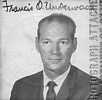
| 
|
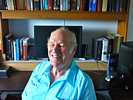
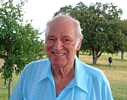
|
|


|
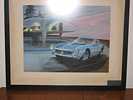
Deam car
|
|
Francis Underwood's career at IBM spanned 30 years of design engineering, including chief architect of the IBM 1401 Data Processing System, co-designer of the IBM 1800 Data Acquisition and Control System, and co-inventor of the forerunner to the floppy disk. He began his IBM career in 1948 at the Endicott NY lab as a customer engineer, where his training included hands-on assembly of punched card accounting machines. He was promoted to a design engineer, teaching switching and logic design classes.
In 1956, he joined Endicott's Advanced Systems Development Department (ASDD) and in 1957 was asked to jump-start IBM's transistorized accounting machine development. In early 1958, based on his Stored-Program Accounting and Calculating Equipment (SPACE) design, he became chief architect of the IBM 1401, announced in October 1959 and one of IBM's most successful and early transistorized products. He transferred to the San Jose lab in 1961 to co-develop the IBM 1800 process control computer and then, in the Instructional Systems Development Department (ISDD), an audio/visual instructional terminal with a forerunner to the floppy disk.
|
This excerpt about his involvement in the invention of the floppy disk:
"After the 1800, I worked in ASDD in the Los Gatos lab developing Educational Systems. This is where Bob Treseder and I invented the floppy disk. We knew nothing of Sony's prior effort. We incorporated it into an Audio/visual unit that would sit on a student's desk.
The disk had a capacity of 32K bytes and was loaded with a program to execute APL, a programming language conceived by Ken Iverson. It was quite popular at that time. In a way, it looked and performed like a PC but with a Selectric typewriter for key entry and printed display. The performance was abysmal and the cost was high, but we had the glimmer of an idea and wanted to pursue it further. However, Educational Systems had another project that usurped our funding. Did I mention that Alan Shugart was the manager of the program? IBM had taken our floppy disk drive idea and given it to the Disk drive Development department. There, the idea of enclosing the tape platter in a paper envelope was born. When this was being readied for production, apparently somebody in management realized that it could be used as a very effective I/O device, cheap, portable and fast, and this could spell doom for IBMs multi-billion dollar card business. The program was killed, and a letter was sent to all that this device was never to be connected to any IBM product. Imagine that!
Alan Shugart, seeing a great opportunity, left IBM, probably with a good deal of the documentation, and started Shugart Associates. I don't believe that IBM thought it was worthwhile to patent this device, so they didn't."
|
In 1972, after two years out of IBM at a startup firm, he returned to San Jose to coordinate engineering development of the IBM 3800 laser Printer.
Francis retired from IBM in 1980 to start an engineering consulting firm designing tools and machines for small manufacturing businesses and metal recovery plants. In 1988 he joined an international firm designing ski lifts for 15 years. Fran was an avid Stearman aerobatic biplane pilot, a watercolor artist and holds six US IBM patents.
|
Wertheim, John - amenschw at aol dot com

|
I joined IBM in 1957 in the Research Division and programmed the IBM 305 Ramac. In 1959 I transferred to Applied Programming in NYC, working for Arnie Wolf and Jack Palmer on 1401 programs, including, first, the Tape-to-Printer Utility, and then co-developing 1401 Autocoder with Gary Mokotoff.
In 1961, I transferred to Endicott, working, first, for Jim Frame, and, later, for Earl Wheeler on IBM 360 software. I managed the programming efforts for BPS, BOS, and later for TOS and DOS operating systems.
I'll fill in more data later. I retired in 1989.
I treasure the memories of our days working together, and I never could understand why IBM paid me to have such fun - those truly are the good old days.
August 2017, Gary Mokotoff advises that John Wertheim is deceased.
|
list from GENE DARROW (contact info removed for now)
DON MANNING
CONTRIBUTION
-MECH. ENG.
-HAMMER UNIT
-CHAIN AND TRAIN
-MAY HAVE SOME EARLY PARTS AND MANUALS
ROBERT GIBSON
CONTRIBUTION
-NOT DIRECTLY ASSOCIATED WITH THE 1403 DEVELOPMENT
-HAS A GOOD MEMORY OF EVENTS AND WAS PRINTER PRODUCTS PLANNING MANAGER
FOLLOWING THE INITIAL DEVELOPMENT ACTIVITY OF THE 1403 PRINTER.
ROBERT GREAVES
CONTRIBUTION
-DURING THE EARLY 1403 DEVELOPMENT,HE WAS ASSISTANT TO THE LAB MGR.
-NO HANDS ON DEVELOPMENT EFFORT
JIM WALSH
CONTRIBUTION
-MECHANICAL ENGINEER- 3RD LEVEL PRODUCT ENGINEERING MGR. DURING A PORTION
OF THE 1403 PROGRAM.
TIM HAYES (SEE NOTE BELOW)
-TIM WAS A MECHANICAL ENGINEER ON THE PROGRAM.
FOR YOUR INFO,THE TWO KEY ELECTRICAL ENGINEERS ON THE PROGRAM ,
AS I REMEMBER WERE JAMES BARCOMB AND FRED SCHAAF.
BOTH OF THEM PASSED AWAY WITHIN THE PAST YEAR.
|
Software chart and offices
go back to main 1401 Restoration Page


